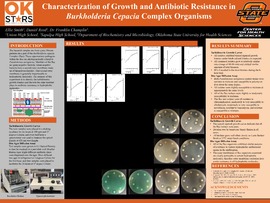| dc.contributor.author | Smith, Ellie | |
| dc.contributor.author | Reed, Daniel | |
| dc.contributor.author | Champlin, Franklin | |
| dc.date.accessioned | 2020-04-14T16:12:37Z | |
| dc.date.available | 2020-04-14T16:12:37Z | |
| dc.date.issued | 2019-02-22 | |
| dc.identifier | ouhd_smith_characterizationof_2019 | |
| dc.identifier.citation | Smith, E., Reed, D., & Champlin, F. (2019, Feb. 22). Characterization of growth and antibiotic resistance in Burkholderia cepacia complex organisms. Poster presented on Research Day at the Oklahoma State University Center for Health Sciences, Tulsa, OK. | |
| dc.identifier.uri | https://hdl.handle.net/11244/323866 | |
| dc.description.abstract | Introduction: Isolates are opportunistic pathogens within the Burkholderia cepacia Complex (Bcc). One key characteristic is that they are gram-negative, thereby making them generally resistant to hydrophobic molecules. | |
| dc.description.abstract | Hypothesis: Exclusionary properties of the gram-negative outer membrane for hydrophobic substances are at least partially responsible in cases where clinical isolates of Bcc species are intrinsically resistant to hydrophobic antibacterial agents. | |
| dc.description.abstract | Study Design: This hypothesis will be tested using turbidimetric growth and disk agar diffusion and bioassays. | |
| dc.description.abstract | Methods: Test samples were cultivated in a shaking incubator for six hours at 180 rpm and 37 degrees Celsius to determine their respective growth rates. Spectrophotometric readings were taken every half hour to measure optical density at 620 nm wavelength. Test samples were also grown to 0.1 optical density and then streaked onto a Petri dish containing Mueller Hinton agar. Eight different antibiotic discs were dispensed onto the seeded agar surfaces and compounds were allowed to diffuse at three degrees Celsius for one hour, and then samples were incubated for 24 hours at 37 degree Celsius. | |
| dc.description.abstract | Results: All Bcc isolates exhibited similar sigmoid growth curves and yielded similar amounts of biomass. Overall, they were slightly susceptible to triclosan and rifampin, and moderately to very susceptible to clindamycin and novobiocin. | |
| dc.description.abstract | Conclusion: The Bcc isolates were pure cultures and exhibited similar in vitro growth characteristics. Their similar patterns of resistance and susceptibility to hydrophobic antibacterial agents suggests phenotypic outer membrane exclusion properties for hydrophobic molecules is largely conserved among the Burkholderia species examined. | |
| dc.format | application/pdf | |
| dc.language | en_US | |
| dc.publisher | Oklahoma State University Center for Health Sciences | |
| dc.rights | The author(s) retain the copyright or have the right to deposit the item giving the Oklahoma State University Library a limited, non-exclusive right to share this material in its institutional repository. Contact Digital Resources and Discovery Services at lib-dls@okstate.edu or 405-744-9161 for the permission policy on the use, reproduction or distribution of this material. | |
| dc.title | Characterization of growth and antibiotic resistance in Burkholderia cepacia complex organisms | |
| osu.filename | ouhd_smith_characterizationof_2019.pdf | |
| dc.type.genre | Presentation | |
| dc.type.material | Text | |
